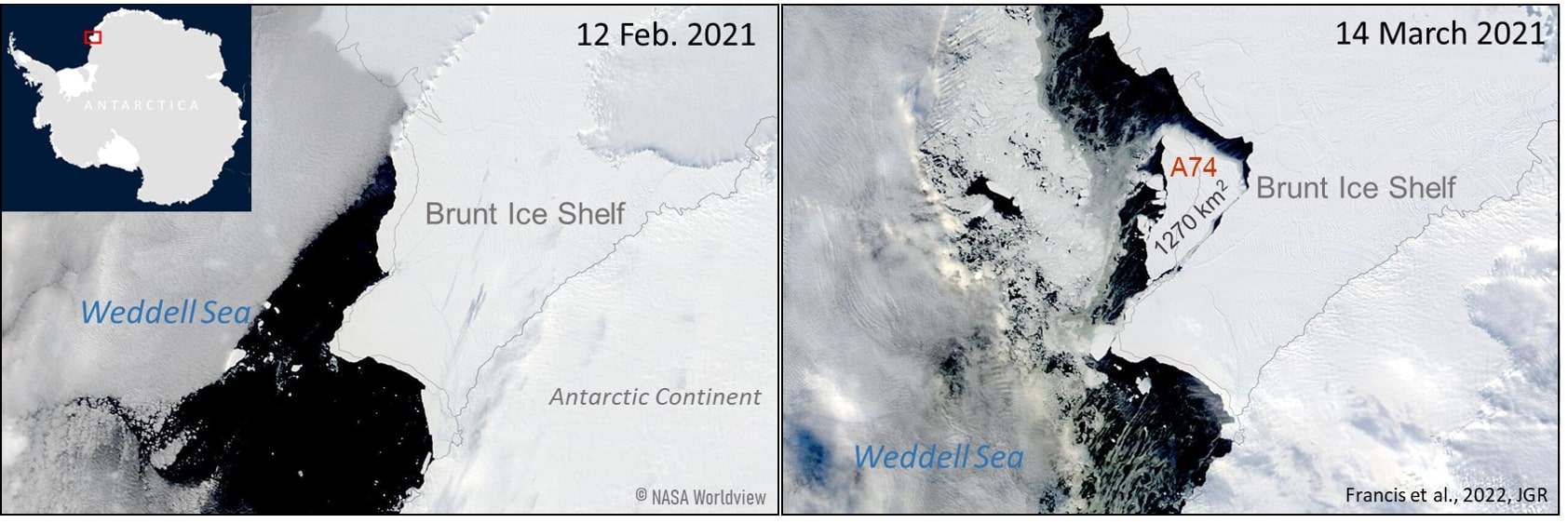
An intense and stationary cyclone around Antarctica caused part of the Brunt Ice Shelf to collapse into the sea; researchers believe increased global temperatures are at play.
As climate change continues around the globe, dramatic scenes play out in Antarctica. Enormous sheets of ice fracture from the edge of the continent, crashing into the sea, the very image of global warming. The breaking and detachment of parts of ice shelves is a natural process, however, known as the glaciological cycle, and although individual events are not cause for concern, they are becoming more common.
A calving event is the process by which a large block of ice gets separated from an ice shelf or glacier and forms an iceberg. Ice shelves are platforms of floating ice that form where the Antarctic ice sheet meets the ocean. Large calving events from these remain highly unpredictable, but the process is typically associated with the glaciological cycle of the ice shelves as well as ocean dynamics. Atmospheric triggers of such events have been largely overlooked, but a team including researchers from Khalifa University identified changes in strong near-surface winds as the cause of one calving event in February 2021.
Dr. Diana Francis, Head of the Khalifa University Environmental and Geophysical Sciences Laboratory (ENGEOS), Dr. Ricardo Fonseca and Charfeddine Cherif, both from ENGEOS, investigated the atmospheric triggers of the calving event with Kyle Mattingly, University of Wisconsin-Madison; Oliver Marsh, British Antarctic Survey; and Stef Lhermitte, Delft University of Technology. Their results were published in Atmospheres.
Iceberg A-74 was calved from the Brunt Ice Shelf when strong near-surface winds associated with intense cyclones amplified the stress on a pre-existing rift in the ice shelf. After calving, the iceberg drifted westward at a speed of 700 meters per day, aided by strong offshore winds.
“Ice shelves around Antarctica make up 11 percent of Antarctica’s total area,” Dr. Francis said. “Over the last few decades, ice shelves have been retreating significantly or have collapsed altogether, and this land-ice loss has important implications for sea-level rise both locally and globally. In fact, ice shelves around Antarctica act as a buffer for the land ice behind, shielding it from ocean swells that may promote further loss of ice. When ice shelves weaken or collapse, ice loss accelerates, causing the sea levels to rise.”
Although much attention focuses on the melting ice caps, calving is the fastest way by which ice contributes to sea-level rise. Ice shelves themselves are floating ice and therefore already displacing water. However, they act as a brake on the flow of ice further inland. “In late February 2021, iceberg A-74 calved from the north side of the Brunt Ice Shelf,” Dr. Francis said. “Although most of the ice loss at this ice shelf has been attributed to the inflow of warm ocean water, the atmospheric conditions above Antarctica may have played a role in triggering this calving event. We know that the number and intensity of cyclones around Antarctica have increased over the last few decades as storm tracks shift towards the pole under enhanced greenhouse-gas concentrations. As the climate continues to warm, the intensity of more frequent cyclones is projected to increase.”
The week before the A-74 calving event saw a strong low-pressure system around the Brunt Ice Shelf, paired with an intense atmospheric river, an elongated band of clouds and high water-vapor content to the northeast of the center of a cyclone. Heavy snowfall fell over the ice shelf, with the researchers suggesting this may have contributed to its destabilization. Strong winds from the cyclone brought more warm air from the atmospheric river, which may have led to high waves hitting the front of the ice shelf. As the cyclone moved eastward and intensified, these forces increased until the calving event was triggered and iceberg A-74 fell into the sea.
This cyclone was deeper and more persistent than an ordinary cyclone, providing the ideal conditions to trigger a calving event. Warm and moist air and wet snow, combined with high ocean waves and swells, weakened the ice-shelf front. Then, strong offshore winds created a steep oceanward sea-surface slope forcing the ice shelf to calve along a pre-existing rift. It took just a few days for the ice shelf to weaken sufficiently for the ocean to force part of it to break.
“Recent studies have found a poleward shift and strengthening of the Southern Hemisphere’s winds, particularly during the summer season, and this has mainly been attributed to ozone depletion,” Dr. Francis said. “However, despite ozone recovery in recent years and the expected reduction in these trends, we’re seeing more frequent stormy periods around Antarctica in the warmer months. Global warming may be causing a continued poleward shift and intensification of the storm track, which means calving events may occur more often in a warming world, with atmospheric forcing playing an increasingly important role. It’s more important than ever that we develop models and data sets to assess and project Antarctic and Greenland ice-shelf dynamics and sea-level rise to better predict their evolution and dynamics.”
Jade Sterling
Science Writer
30 June 2022






